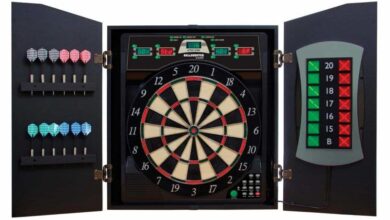Electronic Drum Sets: The Future of Drumming Is Here

Electronic drum sets, also known as e-drums or digital drums, are an electronic alternative to acoustic drum kits.
Electronic drum sets were first introduced in the 1970s and 1980s as drum machines like the Roland TR-808. These early drum machines let drummers replicate drum sounds electronically using analog synthesis. However, the sounds were primitive compared to acoustic drums.
In the 1980s and 1990s, electronic drum sets began using digital samples of acoustic drums rather than synthesized sounds. This allowed electronic drums to sound much closer to real acoustic drums. Electronic drum sets consist of three main components:
-
Drum pads and triggers – These are rubber pads or mesh heads that the drummer strikes, similar to acoustic drums. The pads have sensors that detect the hit, velocity, and location.
-
Sound module – The module contains prerecorded digitized sounds of drums that can be assigned to each pad. The drummer can customize and tweak the sound of each pad.
-
Amplification system – This amplifies the electronic drum sounds so they can be heard. Electronic drums usually output to headphones or a PA system rather than acoustic projection.
Some benefits of electronic drums include:
-
Volume control – Electronic drums can be played silently with headphones for practice.
-
Customizable sounds – Drummers can replicate the sound of any type of drum.
-
Cost – Midrange models are more affordable than professional acoustic kits.
-
Smaller size/portability – E-drums take up less space and are easier to transport.
Some downsides compared to acoustic include:
-
Lack of acoustic projection – E-drums lose the natural acoustic sound and reverberation of acoustic drums.
-
Less realistic feel – The bounce and feedback of pads doesn’t feel quite the same as an acoustic drum head.
-
Equipment challenges – E-drums rely on electricity, amplifiers, wires, and other equipment.
Despite these limitations, electronic drum sets provide a flexible and more affordable alternative for drummers of all skill levels and genres. The technology continues to improve in sound, feel, and functionality.
Types of Electronic Drum Sets
Electronic drum sets come in a wide range of models to suit all budgets and experience levels. Here are the main types to consider:
Beginner and Hobbyist Sets
- Designed for new drummers or casual home use
- Basic pad and module functionality
- Limited sound options (usually 10-50 drum/percussion sounds)
- More affordable pricing under $500
- Good for practice and basic playing
- Examples: Alesis Nitro, Roland TD-1DMK
Mid-Range Sets for Gigging
- Offer enhanced pads, modules, and more drum/percussion sounds
- Sturdy enough for live performances and touring
- Expanded sound libraries with 100-400 sounds
- Additional features like coaching functions
- Modular expandability
- $500-$1500 price range
- Popular choices: Roland TD-17KVX, Alesis Crimson II
High-End Professional Kits
- Pro-level pads with premium feel/response
- Large high-definition touchscreen modules
- Massive sound libraries with 500+ instrument sounds
- Advanced editing, sampling, and customization
- High-quality recordings and acoustic drum replications
- For professional musicians and studio work
- Over $2000, up to $8000
- Top brands: Roland TD-50, Yamaha DTX PRO
Sound Modules and Samples
The sound module, also known as the drum brain, is the heart of an electronic drum set. This is where all of the drum and cymbal sounds are stored and triggered when you strike the pads. Sound modules contain pre-loaded sounds or you can load your own custom samples using software.
Pre-loaded vs Custom Sound Banks
Many drum modules come with a library of quality pre-loaded drum and percussion sounds. These include acoustic drum kits as well as electronic and percussion sounds. Pre-loaded sounds allow you to get playing quickly without having to customize. However, advanced players often prefer loading their own samples for more flexibility and unique sounds. Custom samples can be loaded into compatible modules via USB or SD card.
Sample Quality
High quality drum modules use multilayered samples with multiple velocity layers. This allows the drum sounds to respond dynamically based on how softly or hard you play. Entry-level modules may only use single layer samples, lacking dynamic response. Look for modules advertised with terms like “multi-layer” or “multi-velocity” samples.
Popular Sound Module Brands
Well known sound module brands include Roland, Yamaha, Alesis and more. Roland is respected for its realistic acoustic drum sounds like the V-Drums TD-17. Yamaha offers affordable modules for beginners like the DTX400K with 10 preset kits. Alesis includes percussion and electronic sounds on modules like the Command Kit’s. There are many options at different price points.
Drum Pads
Electronic drum sets use drum pads and cymbal pads in place of acoustic drums and cymbals. The pads contain sensors that detect when and how you strike them, sending electronic signals to the drum module to produce the corresponding drum and cymbal sounds.
Drum pads come in two main types – rubber pads and mesh-head pads. Rubber pads have a solid rubber playing surface stretched over the pad. They are more affordable but have a harder feel compared to acoustic drums. Mesh-head pads use a mesh fabric playing surface stretched over the pad, providing a softer, bouncier feel closer to real drums. Mesh heads are more sensitive and better emulate the feel of playing acoustic drums.
The size of the drum pads also affects playability. Larger pads with a 10 to 12 inch diameter are closest to a real drumset’s feel. Smaller 8 inch pads can feel too cramped. The sensitivity of the pads is also a consideration – more sensitive pads respond better to lighter playing strokes across the whole pad.
In addition to drum pads, electronic kits feature cymbal pads for hi-hats, rides, and crashes. Rubber cymbal pads often mount on stands while higher-end mesh pad cymbals mount on real cymbal stands for more realistic motion. The cymbal pads should be velocity sensitive to detect light taps up to hard hits. Good cymbal pads swivel like real cymbals and provide a natural playing feel.
Rack and Stand
The rack and stand are critical components of an electronic drum set, providing the sturdy foundation required to hold all of the pads and cymbals in place during playing. When shopping for an electronic kit, pay close attention to the rack design and quality.
The rack needs to be sturdy and stable. Look for thicker tubing, usually 1-1.5″ in diameter, along with solid joints and welding. The last thing you want is a shaky, wobbly rack collapsing mid-song. Along with sturdiness, the rack should offer flexibility and adjustability so you can position the pads and cymbals in an optimal, comfortable layout. Most racks allow for height adjustments and have arms that extend, retract, and swivel into different configurations.
The bass drum pedal attaches to the rack to hold the kick pad in place. Make sure the rack has a solid pedal mount and non-slip feet to keep it grounded when pounding on the kick. If using a double bass pedal, ensure the rack has enough space to accommodate two pedals side-by-side.
The rack will also have arms, clamps, and mounts for holding cymbal pads and hi-hat controllers. Look for enough arms to mount the number of cymbals included with the kit and sturdy clamps that hold cymbals firmly without shifting or slipping. The hi-hat mount should offer flexibility in positioning it relative to the snare and bass drum.
Getting the right rack and stand provides the crucial foundation and adjustment flexibility needed for an optimal and comfortable e-kit setup. Check stability, weight limits, and hardware quality before purchasing to ensure your rack can handle your heaviest playing.
Connectivity and Compatibility
Electronic drum sets offer various connectivity options to integrate with other music gear and software. This allows drummers to customise their setups and access advanced features.
- USB and MIDI connections: Most electronic kits have USB and/or MIDI ports to connect to a computer. This allows two-way communication with music software and digital audio workstations (DAWs). Drummers can record MIDI data, trigger and edit drum sounds, and utilize drum learning tools.
- Auxiliary input: Many drum modules have an aux input to connect an external audio source like a smartphone or MP3 player. This allows playing along to backing tracks for practice.
- Software compatibility: Mainstream DAW software like Ableton Live, Logic Pro, Pro Tools, and GarageBand are compatible with electronic kits via USB or MIDI. This provides options for recording, mixing, and producing.
- Smartphone apps: For practice and learning, drummers can utilize smartphone apps and DAWs like GarageBand. These can connect to kits wirelessly via MIDI over Bluetooth or using an audio interface.
- Sound module compatibility: When buying a new kit, check sound module compatibility with computer software and apps. Mainstream modules from Alesis, Roland, and Yamaha tend to have wide compatibility.
Choosing an electronic drum set with extensive connectivity allows drummers to explore creative workflows, recording options, and educational tools. Checking hardware and software compatibility ensures seamless integration.
Features and Customization
One of the best features of an electronic drum set is the ability to customize and expand the drum kit. Many electronic sets come with a variety of built-in sounds and effects that can be programmed and triggered from the drum pads.
The module or “brain” of an electronic kit allows you to change sounds on each individual pad. For example, you could program the snare drum pad to sound like a woodblock or a cowbell. This allows drummers to have a wide selection of drum and percussion sounds at their fingertips.
Most modules also include sequencers, metronomes, and coaching functions to help with practice and songwriting. Sequencers allow you to record and playback drum patterns and loops. The metronome provides a steady pulse for practicing timing and technique. Coaching functions can evaluate your playing and provide feedback for improvement.
One of the biggest advantages of an electronic kit is the ability to easily add more pads and cymbals. Many kits come with ports to connect additional pads, cymbal pads, and percussion triggers. This allows you to expand a basic 5-piece kit into a massive drum set-up with intricate percussion and cymbal work.
Some electronic kits also allow you to customize the size, material, and sensitivity of the drum pads. For example, you may prefer a mesh head snare or a 12-inch tom instead of a 10-inch. With an acoustic kit, it’s much more difficult and expensive to customize sizing.
Advanced electronic kits may include compatibility with specialized software and virtual instruments. This allows the sounds and sequences from the kit to integrate with recording software and synthesizers for even more customization.
The ability to program, expand, and customize an electronic kit is a major advantage for drummers. It provides the versatility and options needed for a wide range of musical genres and recording applications.
Major Brands
When shopping for an electronic drum set, you’ll come across some well-known and reputable brands. Here’s an overview of what some of the major brands have to offer:
Alesis
Alesis is known for making affordable electronic drum sets that are great for beginners and intermediate players. Some of their most popular electronic drum set models include the Alesis Nitro, Alesis Surge, and Alesis Command.
Alesis electronic drum sets range in price from about $300 to $900. They provide a great balance of quality and value. The drum pads and modules may not be as advanced as more expensive brands, but they provide good dynamic response and a variety of built-in sounds.
Roland
Roland is one of the most respected names in electronic drums. Their electronic sets are known for excellent sound quality, durability, and playability.
Some of Roland’s best-selling electronic drum set lines include the TD-1, TD-4, TD-11, and TD-50. Prices range from around $600 up to several thousand dollars.
Roland has pioneered many innovations in electronic drum set technology, like mesh drum heads and supernatural, modelled drum sounds. More expensive Roland models provide an exceptionally realistic playing experience.
Yamaha
Like Roland, Yamaha is a well-known brand in the music world that makes high-quality electronic drum sets. Their DTX and DTXPRO series offer a range of options for all skill levels and budgets.
Yamaha electronic drums provide natural, responsive playing surfaces and a wide selection of drum kits and sounds. Popular Yamaha electronic drum set models include the DTX402, DTX432K, and DTX562K. Prices range from about $600 to over $2,000.
Simmons
Simmons pioneered electronic drum sets in the late 1970s. Today, they continue to make affordable and versatile electronic drum kits, like the SD500 and SD600.
Simmons electronic drums provide a balance of playability, functionality, and value, with prices ranging from about $500 to $1,500. Key features include mesh heads, Chrome pads, and built-in sounds and patterns ideal for practice and live playing.
Cost Considerations
When shopping for an electronic drum set, you’ll find a wide range of prices from entry-level budget kits to professional high-end sets. Consider how much you want to invest upfront as well as any additional purchases you may need to make.
Budget vs Premium Options
Entry-level electronic kits start around $300-$500. These are great for beginners and younger players, though they may lack features and durability for more advanced drummers. Brands like Alesis and Simmons offer budget kits.
Mid-range sets run $600-$1200. These offer better sounds, pads, and modules with room to grow. Roland, Yamaha, and Alesis have excellent mid-priced electronic sets.
Pro-level electronic kits start around $1500+ and can run over $5000. These mimic acoustic kits with superior sounds, premium pads/cymbals, advanced modules, and sturdy hardware. Brands like Roland and Yamaha dominate the high-end market.
Additional Purchases
Beyond the drum set itself, you may need to budget for:
- Headphones for practice without making noise
- Drum throne since most kits don’t include one
- Bass drum pedal
- Extra cables, drum keys, sticks/mallets
Research each model thoroughly so you understand what’s included and can estimate any extra purchases the kit requires. While electronic drums can save money long-term over maintaining acoustic kits, your upfront investment can be significant. Compare brands and features to find the right balance for your needs and budget.
Conclusion
Electronic drum sets offer drummers an incredible amount of flexibility and features compared to acoustic kits. By utilizing drum modules, samples, and velocity-sensitive pads, electronic kits can produce a wide range of realistic acoustic drum sounds, as well as electronic tones. They allow for a high degree of customizability and connectivity with other music gear and software.
For potential buyers, the main considerations are the type of electronic kit (basic, mid-level, pro), the included module and samples, size/number of pads, and budget. Going for a modular, rack-mounted design rather than an all-in-one set can allow easier upgrades and expansions down the road. Leading brands like Roland, Yamaha, and Alesis offer high-quality options across various price points.
Looking ahead, electronic drum sets will likely continue advancing to provide even more authentic feel and a bigger range of expressiveness. We may see innovations like improved pad materials, more advanced sampling methods, and deeper digital customization and connectivity features. As technology progresses, electronic drums will become an increasingly versatile and indispensable tool for drummers and music producers alike.





